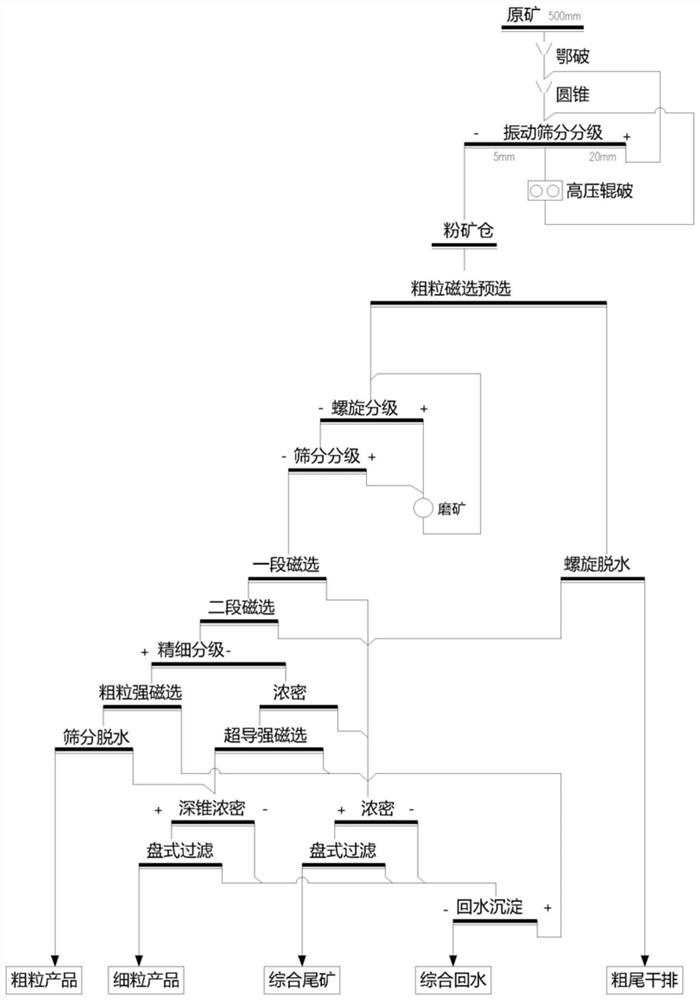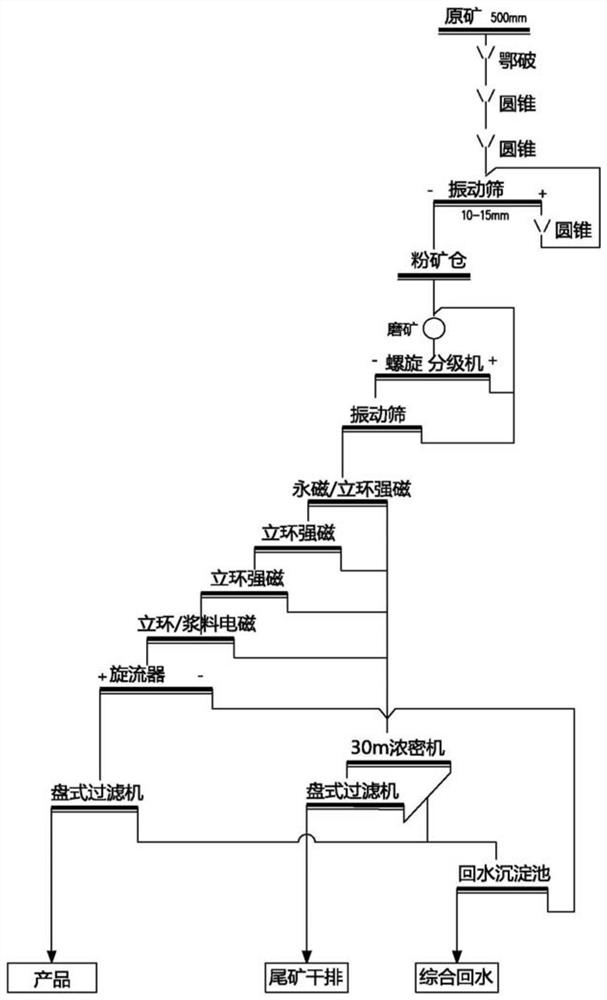Method for preparing ceramic raw material from waste granite stone
A technology for ceramic raw materials and granite, which is applied to the preparation of ceramic raw materials from granite stone wastes. Compared with the traditional processing technology, it can solve the problems of high energy consumption for dehydration, secondary pollution of products, and high energy consumption, and achieves comprehensive The effect of improving technical and economic indicators, refining product structure, and high content of fine particles
- Summary
- Abstract
- Description
- Claims
- Application Information
AI Technical Summary
Problems solved by technology
Method used
Image
Examples
Embodiment 1
[0058] Taking red granite stone solid waste in a certain place in Guangxi as the test object, the test products were tested by Foshan Ceramic Research Institute Testing Co., Ltd. The analysis of waste rock ore samples was calculated by mass percentage, and the K in the sample was 2 O: 6.44-6.69%, Na 2 O: 3.85-3.96%, Fe 2 o 3 : 3.96-4.42%, Al 2 o 3 : 16.21-16.57%, SiO 2 : 65.38-65.45%, TiO 2 : 0.36-0.42%, CaO: 1.87-2.03%, MgO: 0.39-0.41%, the whiteness of raw ore is 6.5-7.3, the flow chart of mineral processing is as follows figure 2 shown.
[0059] (1) Multi-stage crushing: multi-stage crushing includes jaw crushing coarse crushing and cone crushing fine crushing operations, forming a closed circuit with double-layer vibrating screens, 400-600mm large waste rocks are crushed and screened to obtain 3 products, which are +20mm granular materials , 5-20mm pellets and -5mm powder, +20mm pellets return to crush;
[0060] (2) Lamination crushing: Mainly adopt high-pressure ...
Embodiment 2
[0073] This embodiment is basically the same as Embodiment 1, the difference is:
[0074] (3) Coarse particle pre-selection: the -5mm powder obtained in steps (1) and (2) adopts a permanent magnetic drum type magnetic separator with a magnetic field strength of 0.6T to carry out pre-selection and separation to remove relatively strong magnetic coarse-grained materials, Obtain non-magnetic coarse grade products;
[0075] (6) Multi-stage magnetic separation: the -0.38mm sieve product in step (4) is obtained by two-stage magnetic separation to obtain magnetic and non-magnetic materials, mainly to remove mechanical iron impurities, mica and weak magnetic materials. Two-stage magnetic separation includes The first-stage magnetic separation adopts a drum-type field-strength magnetic separator with a magnetic field strength of 1.0T, and the second-stage magnetic separation adopts a high-gradient vertical ring electromagnetic magnetic separator with a magnetic field strength of 1.5T; ...
Embodiment 3
[0078] This embodiment is basically the same as Embodiment 1, the difference is:
[0079] (3) Coarse grain pre-selection: the -5mm powder obtained in steps (1) and (2) is pre-selected and separated by a permanent magnetic drum type magnetic separator with a magnetic field strength of 1.2T to remove relatively strong magnetic coarse grained materials, Obtain non-magnetic coarse grade products;
[0080] (6) Multi-stage magnetic separation: the -0.38mm sieve product in step (4) is obtained by two-stage magnetic separation to obtain magnetic and non-magnetic materials, mainly to remove mechanical iron impurities, mica and weak magnetic materials. Two-stage magnetic separation includes The first-stage magnetic separation adopts a drum-type field-strength magnetic separator or a plate-type magnetic separator with a magnetic field strength of 0.8T, and the second-stage magnetic separation adopts a high-gradient vertical ring electromagnetic magnetic separator with a magnetic field st...
PUM
| Property | Measurement | Unit |
|---|---|---|
| whiteness | aaaaa | aaaaa |
| whiteness | aaaaa | aaaaa |
| whiteness | aaaaa | aaaaa |
Abstract
Description
Claims
Application Information
 Login to View More
Login to View More - R&D
- Intellectual Property
- Life Sciences
- Materials
- Tech Scout
- Unparalleled Data Quality
- Higher Quality Content
- 60% Fewer Hallucinations
Browse by: Latest US Patents, China's latest patents, Technical Efficacy Thesaurus, Application Domain, Technology Topic, Popular Technical Reports.
© 2025 PatSnap. All rights reserved.Legal|Privacy policy|Modern Slavery Act Transparency Statement|Sitemap|About US| Contact US: help@patsnap.com



